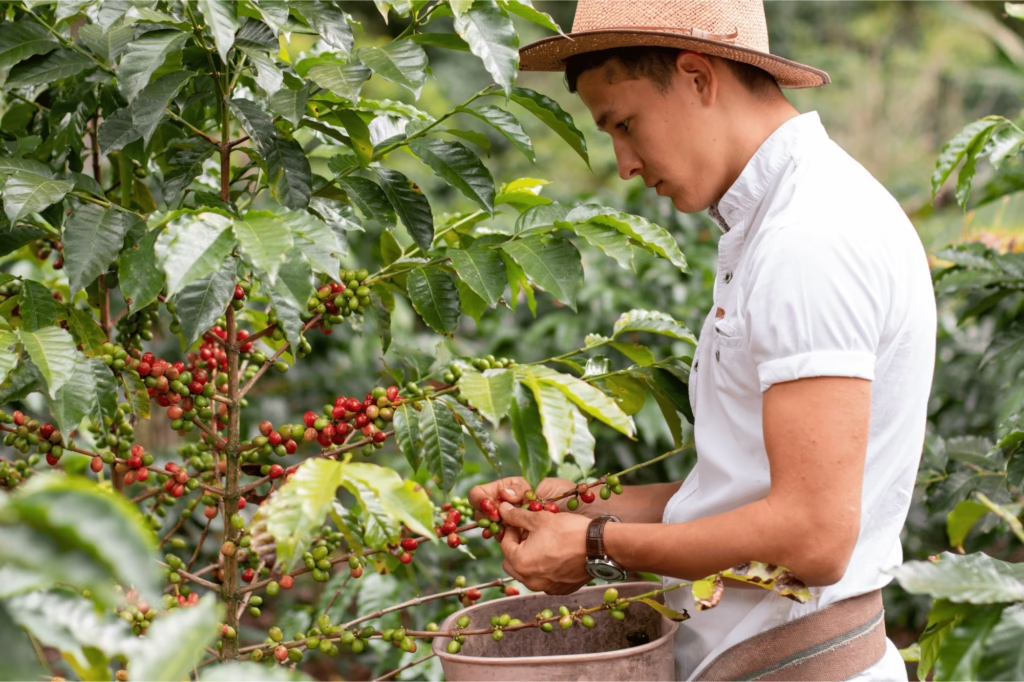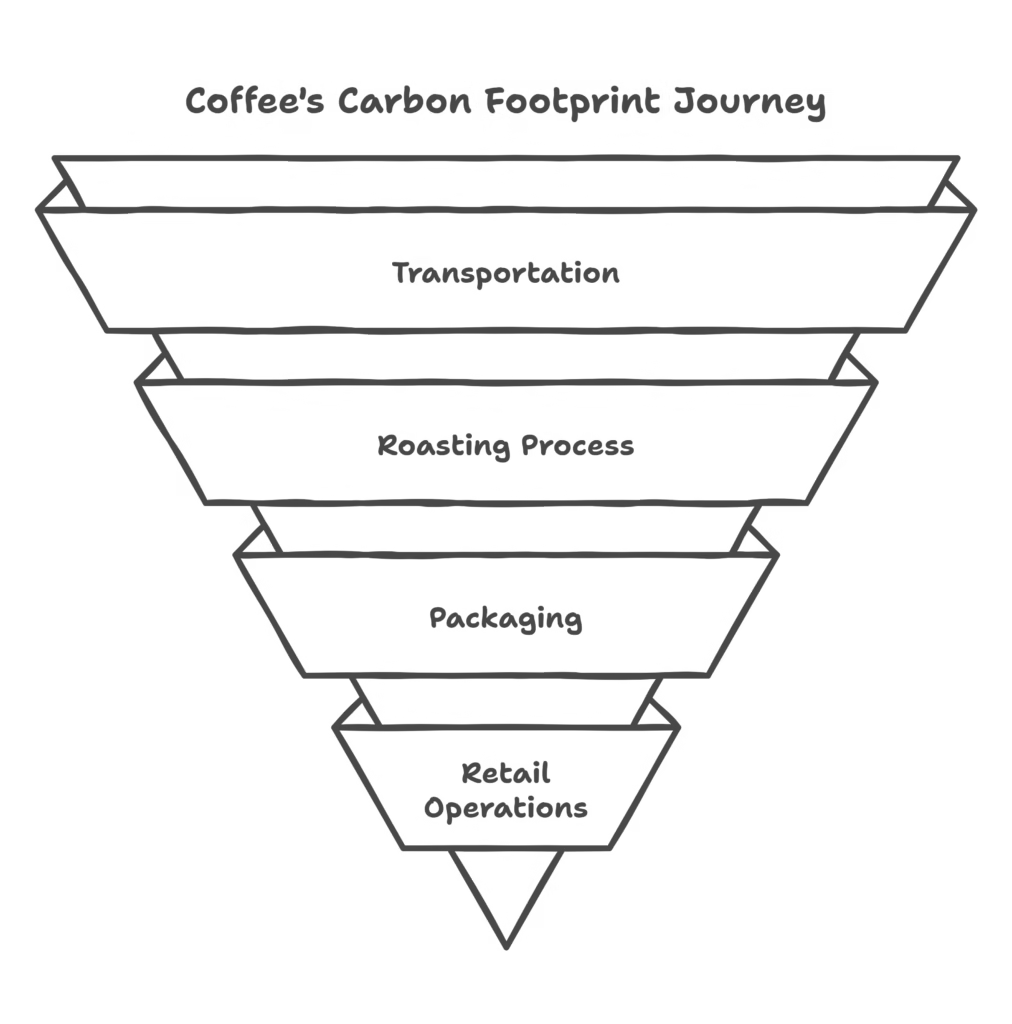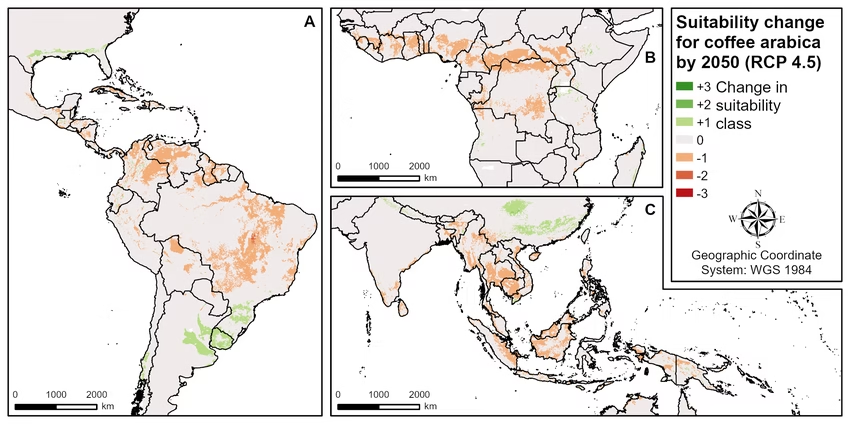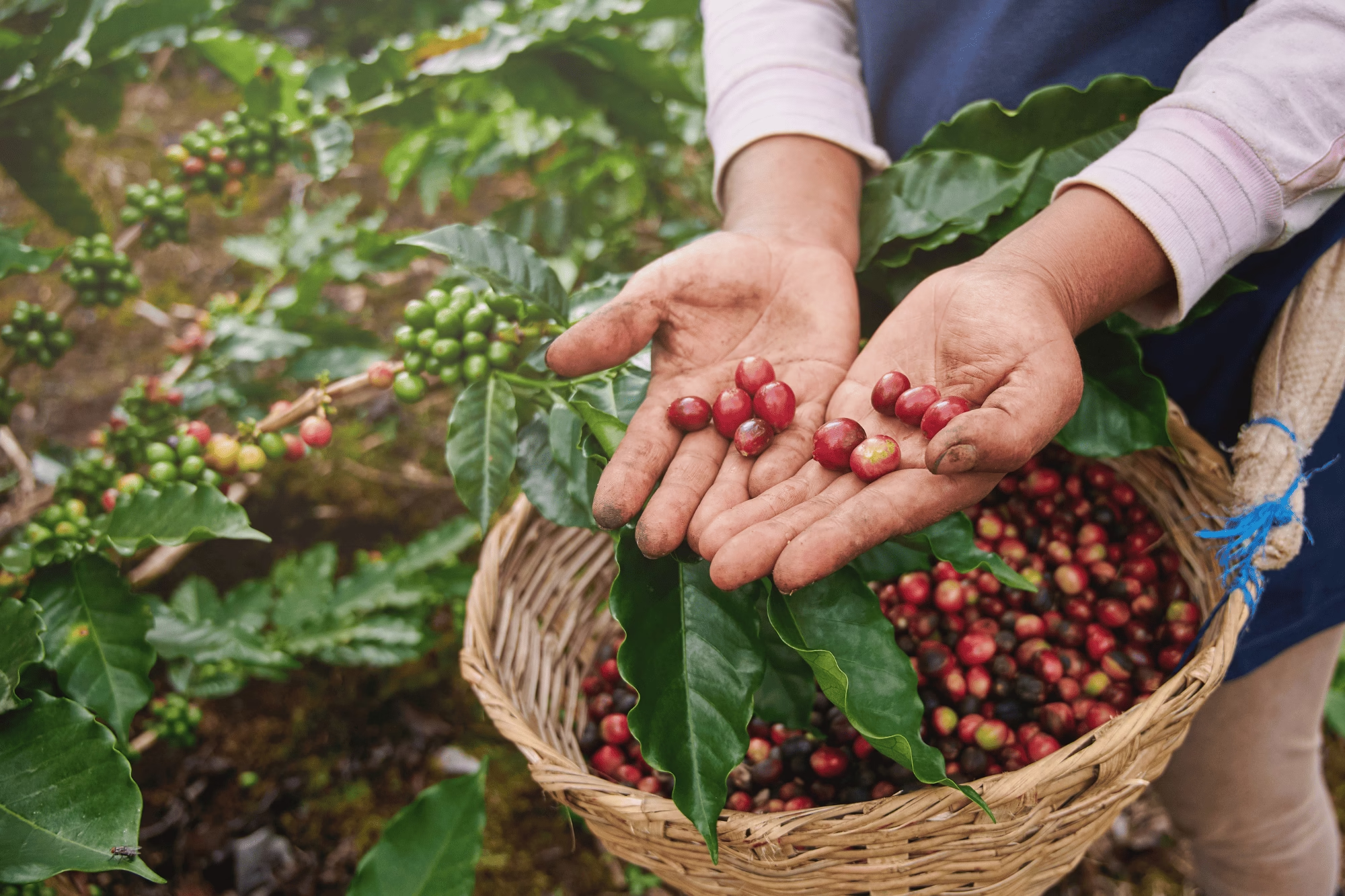That morning cup of coffee that kickstarts your day might be contributing more to climate change than you realize. As I sipped my own coffee this morning, I found myself wondering about the journey those beans took before reaching my cup and the environmental footprint they left behind. In this article, I will explain how the coffee farming impact in global warming.
Coffee is the world’s most popular beverage, with over 2 billion cups consumed daily. But behind this global addiction lies a troubling reality: coffee farming is both a victim of and a contributor to global warming. This complex relationship threatens not only our beloved beverage but also the livelihoods of 25 million coffee farmers worldwide.
Table of Contents
How Does Coffee Farming Contribute to Global Warming?
Coffee farming impacts our climate in several significant ways, creating a feedback loop that ultimately threatens the very crop itself. Let’s break down the primary culprits:
The Deforestation Dilemma
Traditional coffee was originally grown under forest canopies, coexisting with native ecosystems. But as global demand grew, so did the need for higher yields. This led to what I consider one of the most devastating practices in coffee production: forest clearing for sun-grown coffee.
When forests are cleared for coffee plantations, we lose crucial carbon sinks. A single hectare of tropical forest can store about 250 tons of carbon. Once cleared, that stored carbon releases into the atmosphere as CO2, contributing directly to global warming.
In coffee-growing regions like Brazil, Vietnam, and Colombia, this agricultural deforestation has been particularly aggressive. Between 1990 and 2020, coffee-producing countries lost significant portions of their forest cover, with some regions experiencing deforestation rates up to 35%.

Fertilizer Fallout
Coffee plants are hungry crops, especially the high-yield varieties grown in full sun. To meet this hunger, farmers apply nitrogen-based fertilizers, which might seem harmless but actually create a serious climate problem.
When these fertilizers break down, they release nitrous oxide (N2O) – a greenhouse gas approximately 300 times more potent than CO2. I’ve spoken with soil scientists who confirm that over-fertilization in coffee regions has led to significant N2O emissions, particularly in intensive farming operations.
Processing Problems
After harvesting, coffee cherries need processing to extract the beans. The two main methods – wet processing and dry processing – both create environmental challenges:
- Wet processing: Requires substantial water usage and generates wastewater containing organic matter. When this wastewater enters waterways without proper treatment, it decomposes and releases methane, another potent greenhouse gas.
- Dry processing: While less water-intensive, it creates organic waste that, if improperly managed, also generates methane emissions during decomposition.
The Carbon-Heavy Supply Chain

Each step adds to coffee’s carbon footprint, with estimates suggesting that a single pound of coffee generates about 11 pounds of CO2 equivalent.
Does Coffee Production Lead to Deforestation?
The short answer is yes coffee production has been a significant driver of deforestation in tropical regions. But the relationship is more nuanced than you might think.
The Shift to Sun-Grown Coffee
Traditionally, coffee grew in the shade of forest canopies as an understory crop. This “shade-grown” method preserves forests and biodiversity. However, in the 1970s, a major agricultural shift occurred when new hybrid varieties designed for sun exposure entered the market.
These sun-tolerant varieties promised higher yields about 30% more than shade-grown coffee but required clear-cutting forests. The financial incentives were simply too strong for many farmers to resist, especially those struggling with poverty.
In countries like Vietnam, Indonesia, and parts of Central America, coffee expansion has directly caused deforestation. For example, between 1990 and 2010, Vietnam lost approximately 80,000 hectares of forest annually, with coffee expansion being a significant factor.
The Biodiversity Connection
This deforestation doesn’t just release carbon it devastates biodiversity. Shade-grown coffee farms can host up to 150 bird species, while sun-grown plantations support fewer than 20. This biodiversity loss further compromises ecosystem resilience to climate change.
Can Sustainable Coffee Farming Help Reduce Global Warming?
Absolutely. The good news is that coffee farming doesn’t have to be environmentally destructive. In fact, sustainable coffee farming practices can actually help combat climate change.
Return to Shade-Grown Methods
I visited a shade-grown coffee farm in Costa Rica last year and was amazed by the difference. Unlike the monoculture plantations I’d seen elsewhere, this farm was a thriving ecosystem. Birds called from the canopy while coffee plants grew beneath, protected from extreme weather events by the trees above.
Shade-grown coffee systems:
- Sequester 15-30% more carbon than sun-grown systems
- Reduce the need for chemical fertilizers
- Provide natural pest control through biodiversity
- Create more resilient farming systems
Agroforestry and Carbon Sequestration
Agroforestry—combining trees with agricultural crops—offers particular promise for coffee farming. By integrating nitrogen-fixing trees like Erythrina and Inga species with coffee plants, farmers can improve soil fertility naturally while sequestering carbon.
Research indicates that coffee agroforestry systems can sequester between 15 and 30 metric tons of carbon per hectare, significantly offsetting emissions from other aspects of production.
Improved Processing Methods
Innovative processing methods are reducing the climate impact of post-harvest operations:
- Eco-pulpers that use 80% less water than traditional wet processing
- Methane capture systems that trap biogas from coffee wastewater for energy production
- Composting of coffee pulp to create organic fertilizer, closing the nutrient loop
One cooperative in Nicaragua I read about has implemented methane capture from their processing wastewater, reducing emissions while generating enough energy to power their entire processing facility.
How Do Organic Farming Methods Reduce Environmental Impact?
The shift to organic farming represents one of the most promising paths forward for reducing coffee’s climate impact.
Chemical-Free Cultivation
Conventional coffee farming relies heavily on synthetic fertilizers and pesticides, both of which contribute to greenhouse gas emissions during their manufacture and application. Organic farming eliminates these inputs, replacing them with:
- Compost and organic matter to build soil fertility
- Natural pest control through predator-prey relationships
- Manual weed management instead of herbicides
These methods not only reduce direct emissions but also build healthier soils that sequester more carbon. Studies suggest organic coffee farms emit 40% less greenhouse gases than conventional farms.
Soil Health and Carbon Storage
Organic farming methods significantly improve soil health, which directly impacts carbon sequestration. Healthy soils can store more carbon, keeping it out of the atmosphere where it would contribute to warming.
Practices like cover cropping, mulching, and composting increase soil organic matter (SOM). For every 1% increase in SOM, soils can sequester approximately 8 tons of carbon per hectare. This makes organic coffee farming a potential carbon sink rather than a carbon source.
Water Conservation
Organic farming typically uses water more efficiently than conventional methods. Through practices like:
- Drip irrigation
- Rainwater harvesting
- Soil moisture conservation through mulching
These water-saving practices reduce the energy needed for irrigation and decrease the methane emissions associated with wastewater.
How Does Climate Change Affect Coffee Farmers?
In a cruel irony, coffee farmers who contribute to climate change through their farming practices are also among its first and most severely impacted victims.
Rising Temperatures, Falling Yields
Coffee is remarkably temperature-sensitive. Arabica coffee, which accounts for about 60% of global production, grows best at temperatures between 18-22°C (64-72°F). Even small temperature increases can significantly reduce yields and quality.
With global temperatures rising, many traditional coffee-growing regions are becoming less suitable for production. Research suggests that by 2050, the area suitable for coffee cultivation could decrease by up to 50%.
Unpredictable Weather Patterns
Climate change brings more extreme and unpredictable weather events, creating challenges for coffee farmers:
- Unseasonal rains disrupt flowering cycles
- Prolonged droughts stress plants and reduce yields
- Severe storms damage plantations and infrastructure
These disruptions make planning increasingly difficult for farmers and lead to significant crop losses. During a recent trip to a coffee region in Colombia, farmers told me they can no longer rely on traditional growing calendars that had guided their families for generations.
Pest and Disease Pressure
Warmer temperatures have expanded the range of coffee’s most devastating pest: the coffee berry borer. This tiny beetle causes an estimated $500 million in damage annually, and its range is expanding as temperatures rise.
Similarly, diseases like coffee leaf rust (Hemileia vastatrix) are becoming more prevalent in higher elevations previously too cool for the fungus to thrive. A major leaf rust outbreak in 2012-2013 caused over $1 billion in damages and cost thousands of jobs across Central America.
Which Countries Are Most Affected by Climate Change in Coffee Farming?
The impacts of climate change on coffee production vary significantly by region, with some countries facing particularly severe challenges.
Central America: On the Front Lines
Countries like Guatemala, Honduras, and Nicaragua are experiencing some of the most dramatic coffee-related climate impacts. These nations rely heavily on coffee exports yet face increasing temperatures, changing rainfall patterns, and more frequent extreme weather events.
In Honduras, coffee farmers at lower elevations have already been forced to abandon production or switch to more heat-tolerant crops. Some have migrated to higher elevations, sometimes causing conflicts over land use.
East Africa: Shifting Growing Zones
Ethiopia coffee’s birthplace and neighboring countries like Kenya and Tanzania are seeing their coffee-growing zones shift upward in elevation and shrink in total area.
In Ethiopia, studies project that suitable coffee-growing areas could decrease by 65% by 2080. This is particularly concerning as over 15 million Ethiopians depend on coffee for their livelihoods.
Small Island Producers: Existential Threats
Island coffee producers like Jamaica (known for Blue Mountain coffee) and Hawaii (Kona coffee) face existential threats from climate change. Rising temperatures, increased hurricane intensity, and sea-level rise threaten not just coffee production but entire economies and ways of life.

Is There a Link Between Coffee Farming and Biodiversity Loss?
The connection between coffee farming, biodiversity loss, and global warming forms a dangerous feedback loop that threatens both coffee production and global climate stability.
The Biodiversity Coffee Connection
Traditional shade-grown coffee farms support remarkable biodiversity—up to 70% of the species found in natural forests. This biodiversity provides crucial ecosystem services like:
- Natural pest control
- Pollination
- Soil health maintenance
- Climate regulation
When forests are cleared for sun-grown coffee, this biodiversity collapses, and with it go these essential services. The result? Farmers become more dependent on chemical inputs, further contributing to emissions.
Beyond the Farm: Landscape Impacts
Coffee farming affects biodiversity beyond plantation boundaries. Erosion from exposed soils leads to sedimentation in waterways, harming aquatic ecosystems. Agricultural runoff carrying fertilizers and pesticides causes additional damage through water pollution.
In regions where coffee expansion drives deforestation, habitat fragmentation threatens wildlife populations. The golden-winged warbler, a migratory bird that winters in Central American coffee regions, has declined by 66% since the 1960s, partly due to habitat loss in coffee-growing areas.
Reversing the Trend
Encouragingly, biodiversity-friendly coffee farming is gaining traction. Certification programs like Bird Friendly, Rainforest Alliance, and Smithsonian Migratory Bird Center promote farming methods that protect biodiversity while reducing climate impacts.
These programs incentivize practices like:
- Maintaining diverse shade canopies
- Creating wildlife corridors
- Eliminating harmful pesticides
- Implementing water conservation measures
How Does Water Use in Coffee Farming Impact Global Warming?
Water usage in coffee production intersects with climate change in several important ways.
The Water Footprint of Your Cup
Coffee is surprisingly water-intensive. Producing a single cup of coffee requires about 140 liters of water when accounting for cultivation, processing, and preparation. Much of this water becomes contaminated with agricultural chemicals or organic waste.
When this water evaporates or runs off into waterways carrying nitrogen-rich compounds, it can trigger processes that release greenhouse gases:
- Nitrogen runoff leads to algal blooms
- These blooms eventually die and decompose
- Decomposition creates oxygen-depleted zones where methane-producing bacteria thrive
Water Stress and Energy Use
As climate change makes rainfall less reliable in many coffee regions, farmers increasingly turn to irrigation. Powering irrigation systems typically requires electricity or diesel fuel, both of which generate greenhouse gas emissions.
The relationship becomes cyclical: climate change reduces water availability, leading to more energy-intensive irrigation, which further contributes to climate change.
Innovative Solutions
Progressive coffee farms are implementing water-smart practices that reduce both water usage and associated emissions:
| Conventional Approach | Water-Smart Alternative | Climate Benefit |
|---|---|---|
| Wet processing requiring 15L water per kg coffee | Eco-pulping using 3L water per kg coffee | 80% reduction in water usage and associated methane emissions |
| Untreated wastewater discharge | Wastewater treatment and methane capture | Prevents methane emissions and generates renewable energy |
| Flood irrigation | Precision drip irrigation | Reduces water usage and energy needed for pumping |
| Bare soil cultivation | Mulching and cover crops | Reduces water evaporation and builds carbon-sequestering soil |
Sustainable Coffee Farming Practices to Reduce Carbon Footprint
For coffee to have a future in a warming world, the industry must embrace comprehensive sustainability practices. Here are the most promising approaches:
Carbon-Negative Coffee Production
Some pioneering farms aren’t just reducing emissions they’re becoming carbon sinks. By combining agroforestry, organic methods, and renewable energy, these operations sequester more carbon than they emit.
A recent study of coffee farms in Costa Rica found that optimized agroforestry systems could sequester up to 36 tons of carbon per hectare, more than offsetting the emissions from production and processing.
Circular Economy Approaches
Innovative farmers are finding ways to utilize every byproduct of coffee production:
- Coffee pulp becomes compost or animal feed
- Prunings become biochar that sequesters carbon while improving soil
- Processing wastewater generates biogas for energy
- Spent coffee grounds from roasters return to farms as soil amendments
These circular approaches dramatically reduce waste while creating closed-loop systems that minimize external inputs and their associated emissions.
Climate-Smart Varieties
Plant breeding programs are developing coffee varieties better adapted to changing conditions while requiring fewer inputs. These climate-smart varieties feature:
- Heat tolerance
- Disease resistance
- Drought tolerance
- Higher carbon sequestration capacity
The World Coffee Research organization has launched a global effort to develop and distribute these varieties to vulnerable growing regions, potentially saving millions of livelihoods while reducing the climate impact of production.
Conclusion: From Crisis to Opportunity
The relationship between coffee farming and global warming presents both an urgent challenge and a remarkable opportunity. By transforming how coffee is grown, processed, and distributed, we can turn this popular crop from a climate liability into a climate solution.
For consumers, supporting this transformation means:
- Choosing shade-grown and organic certified coffees
- Looking for direct trade relationships that ensure farmers can afford sustainable practices
- Being willing to pay prices that reflect the true environmental cost of production
- Reducing waste in home brewing and consumption
For the industry, it requires investment in:
- Helping farmers transition to sustainable methods
- Developing climate-resilient supply chains
- Researching and implementing carbon-negative production systems
- Creating transparent reporting on climate impacts
And for policymakers, it means creating frameworks that:
- Reward environmental services provided by sustainable coffee farms
- Penalize high-emission production methods
- Support vulnerable farming communities through climate transitions
- Invest in research and development for climate-smart agriculture
The future of coffee—and the millions who depend on it—hangs in the balance. But with concerted action, your morning cup could become part of the solution rather than part of the problem.
What will you do to ensure your coffee habit helps rather than harms our warming planet?

